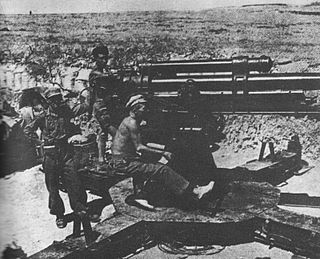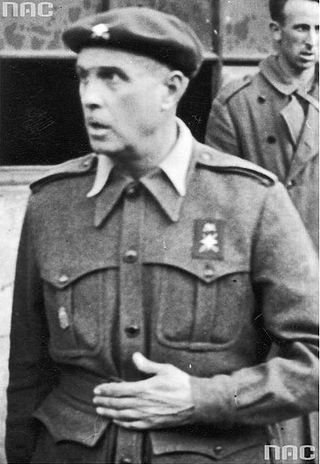
The Battle of the Ebro was the longest and largest battle of the Spanish Civil War and the greatest, in terms of manpower, logistics and material ever fought on Spanish soil. It took place between July and November 1938, with fighting mainly concentrated in two areas on the lower course of the Ebro River, the Terra Alta comarca of Catalonia, and the Auts area close to Fayón (Faió) in the lower Matarranya, Eastern Lower Aragon. These sparsely populated areas saw the largest array of armies in the war. The battle was disastrous for the Second Spanish Republic, with tens of thousands left dead or wounded and little effect on the advance of the Nationalists.
Rafael García Valiño was a Spanish army officer who fought in the Spanish Civil War for the Nationalist faction.

Enrique Líster Forján was a Spanish communist politician and military officer.
The Second Battle of the Corunna Road was a battle of the Spanish Civil War that took place from 13 December 1936 to 15 January 1937, northwest of Madrid. In December 1936, the Nationalists launched an offensive in order to cut the Corunna Road and isolate Madrid, but a Republican counter-offensive stopped the Nationalist advance. The Nationalists cut the Corunna road but failed to encircle Madrid.

The Battle of Teruel was fought in and around the city of Teruel during the Spanish Civil War between December 1937 and February 1938, during the worst Spanish winter in 20 years. The battle was one of the bloodiest actions of the war, with the city changing hands several times by first falling to the Republicans and eventually being retaken by the Nationalists. In the course of the fighting, Teruel was subjected to heavy artillery and aerial bombardment. In the two-month battle, both factions together took 110,000 casualties.
Sebastián Pozas Perea was a Spanish military officer and civil servant.

The War in the North was a theatre of the Spanish Civil War that occurred in northern Spain from 31 March to 21 October 1937.

The Aragon Offensive was an important military campaign during the Spanish Civil War, which began after the Battle of Teruel. The offensive, which ran from March 7, 1938, to April 19, 1938, smashed the Republican forces, overran Aragon, and conquered parts of Catalonia and the Levante.

José Solchaga Zala was a Spanish general who fought for the Nationalists in the Spanish Civil War.

The XI International Brigade fought for the Spanish Second Republic in the Spanish Civil War.

The XYZ Line, also known as the Matallana Line, was a system of fortifications built in 1938 during the Spanish Civil War to defend Valencia, the capital of the Second Spanish Republic. The XYZ Line was a simple system of trenches and bunkers, built to withstand heavy artillery or 450-kilogram (992 lb) aerial bombs, and took advantage of some of the most difficult terrain in Spain in the Iberian System ranges to the north and northeast of Valencia. The XYZ Line was successful at halting the Nationalist advance on Valencia, being one of the last Republican victories of the war, and allowed the Republicans to start the Battle of the Ebro.

Antonio Cordón García was a Spanish soldier, born in Sevilla, who commanded during the Spanish Civil War.

The Asturias Offensive was an offensive in Asturias during the Spanish Civil War from 1 September to 21 October 1937.

The Segovia Offensive was a Republican diversionary offensive which took place between 31 May and 6 June 1937, during the Spanish Civil War. The main goal of the offensive was to occupy Segovia and divert Nationalist forces from their advance on Bilbao. After a brief initial advance the offensive failed due to Nationalist air superiority.

The Huesca Offensive was an operation carried out during the Spanish Civil War by the Republican Army in June 1937 in order to take the Aragonese city of Huesca, which since the start of the war in July 1936 had been under the control of the Nationalist forces.
The Battle of Caspe took place during the Aragon Offensive of the Spanish Civil War in 16–17 March 1938.
Luis Barceló Jover was a Spanish military officer.
Francisco Galán Rodríguez (1902–1971), was a Spanish military officer.

Etelvino Vega Martínez (1906–1939) was a Spanish politician and military officer.

The Levante Offensive, launched near the end of March 1938, was an attempt by Nationalist forces under Francisco Franco to capture the Republican held city of Valencia during the Spanish Civil War. The Nationalists occupied the province of Castellón, but the offensive failed due to bad weather and the dogged resistance of the Republican troops at the XYZ defensive line.











